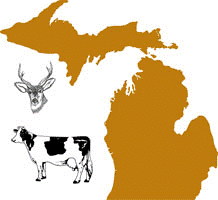Wildlife Disease and Zoonotics
Date of this Version
2002
Abstract
White-tailed deer ( Odocoileus virginianus ) are reservoirs for Mycobacterium bovis in northeast Michigan, USA. Production of nitric oxide (NO) by activated macrophages is a potent mechanism of mycobacterial killing. The capacity of macrophages to produce NO, however, varies among mammalian species. The objective of this study was to determine if mononuclear cells from white-tailed deer produce nitrite as an indication of NO production and, if so, is NO produced in response to stimulation with M. bovis antigens. Supernatants were harvested from adherent peripheral blood mononuclear cell (PBMC) cultures that had been stimulated with either Mannheimia haemolytica lipopolysaccharide (LPS) or media alone (i.e., no stimulation). Nitrite levels within M. haemolytica LPS-stimulated culture supernatants exceeded (P < 0.05) those detected within supernatants from non-stimulated cultures as well as those detected within supernatants from cultures receiving an inhibitor of NO synthase in addition to M. haemolytica LPS. In response to stimulation with M. bovis antigens, nitrite production by PBMC from M. bovis -infected deer exceeded (P < 0.05) the production by PBMC from non-infected deer. The response of PBMC from infected deer to M. bovis antigens exceeded (P < 0.05) the response of parallel cultures from the same deer receiving no stimulation. The response of PBMC from M. bovis -infected deer to M. avium antigens did not differ from that of PBMC from M. bovis infected deer to no stimulation or from that of PBMC from non-infected deer to M. avium antigens. These findings indicate that adherent PBMC from white-tailed deer are capable of NO production and that mononuclear cells isolated from M. bovis -infected white-tailed deer produce NO in an antigen-specific recall response.


Comments
Published in Journal of Wildlife Diseases, 38(2), 2002, pp. 338–343.